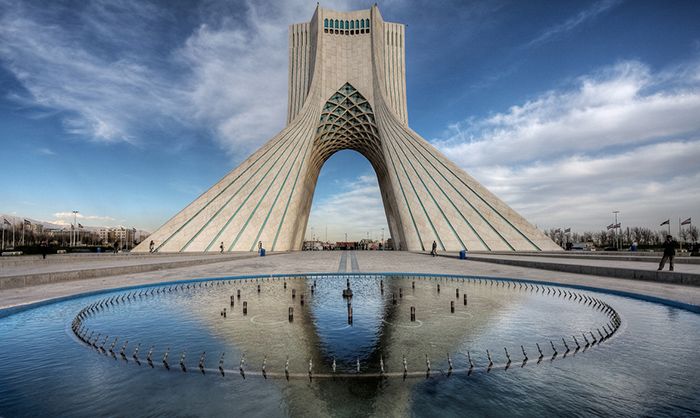The Azadi Tower
(Persian: برج آزادی, Borj-e Āzādi; “Freedom Tower”), formerly known as the Shahyad Tower (برج شهیاد, Borj-e Šahyād; “Shah’s Memorial Tower”), is a monument on Azadi Square in Tehran, Iran. It is one of the landmarks of Tehran, marking the west entrance to the city, and is part of the Azadi Cultural Complex, which also includes an underground museum.
The tower is about 45 metres (148 ft) tall and is completely clad in cut marble. It was commissioned by Mohammad Reza Pahlavi, the last Shah of Iran, to mark the 2,500-year celebration of the Persian Empire and completed in 1971. It also serves as the country’s kilometre zero.
After winning a competition, architect Hossein Amanat was tasked to design the tower. His ideas were based upon classical and post-classical Iranian architecture, popular influences on art in the 1960s following the White Revolution.
The first name associated with this monument was Darvāze-ye Kuroš (“Gate of Cyrus”), and at the time of the Centenary Celebrations, Asadollah Alam, who chaired the Council of Celebrations, referred to the monument as Darvāze-ye Šāhanšāhi (“Imperial Gate”). The monument’s ultimate official name was decided before the announcement of the competition for the monument’s design in September 1966. Bahram Farahvashi, a scholar and professor of ancient Iranian languages who worked with the Council of Celebrations, came up with the officially designated name of the structure, Šahyād Āryāmehr. Built in 1971 in commemoration of the 2,500th year of the foundation of the Persian Empire, this “gateway into Tehran” was named the Šahyād (“Shah’s Memorial”) in honor of the Shah (Mohammad Reza Pahlavi), but was later renamed Āzādi (“Freedom”) following the 1979 Revolution.

Construction
During the 1960s, Iran became a major oil-exporting country, and using the newly-found wealth, the Shah launched programs to modernize and industrialize the country. This followed a cultural growth that architect Hossein Amanat describes as “a mini renaissance”. In 1966, Amanat won a competition to design the building.
Due to governmental concerns, Amanat was required to sign underneath contracts “on condition of the approval of the Council of Celebrations”, which would serve as the client. Amanat planned to contract the British company of Arup to assist in the structural design of the tower, as he was impressed by their contributions towards the design and construction of the Sydney Opera House. He initially faced opposition from the head of the council, as well as several conservative and nationalistic Iranian engineers, as he was turning to a foreign engineer for assistance. Despite that, the Shah supported Amanat, sending a letter to the council which would leave the decision to the architect. Shahbanu Farah Pahlavi was also supportive of Amanat’s decisions.
Amanat told the BBC World News in an interview that “overall, the building starts from the base and moves up towards the sky.” He states that he was inspired to design the tower in this way because he felt that Iran “should be moving towards a higher level.” According to him, the main vault is a Sassanian arch representing the classical era, while the broken arch above it is a popular medieval form of arch representing the post-classical era. The “network of ribs“, which connects the arches together, would represent the connection between classical and post-classical Iran.
Built with white marble from Isfahan Province, the monument includes 8,000 blocks of stone. The stones were all located and supplied by Ghanbar Rahimi, who was well known for his extensive knowledge of quarries, often known as the Soltān-e Sang-e Irān (“Iran’s Sultan of Stone”). Computers were used to “define its complex woven surfaces,” which, at the time, was a new technological technique. The main contractor for the construction of the tower was the MAP Company, supervised by Ghaffar Davarpanah Varnosfaderani, a renowned Iranian stonemason. The project was mainly funded by a group of five hundred Iranian industrialists. According to a report by MEED, the construction cost about six million dollars.
On October 16, 1971, the inauguration of the tower took place. However, it was not until January 14, 1972 that the tower was open to the public.





